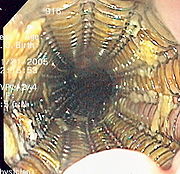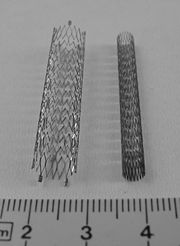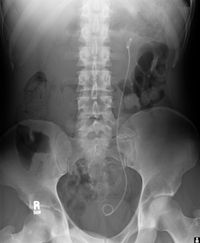Stent



In medicine, a stent is an artificial 'tube' inserted into a natural passage/conduit in the body to prevent, or counteract, a disease-induced, localized flow constriction. The term may also refer to a tube used to temporarily hold such a natural conduit open to allow access for surgery.
Contents |
Etymology
The origin of the word stent remains unsettled. The verb stenting was used for centuries for the process of stiffening garments (a usage long obsolete, per the Oxford English Dictionary) and some believe this to be the origin. Others attribute the noun stent to Jan F. Esser, a Dutch plastic surgeon who in 1916 used the word to describe a dental impression compound invented in 1856 by the English dentist Charles Stent (1807–1885), which Esser employed to craft a form for facial reconstruction. The full account is described in the Journal of the History of Dentistry.[1] According to the author, from the use of Stent's compound as support for facial tissues grew the eventual use of stent to open various bodily structures. Worth noting though is that the first "stents" used in medical practice were initially called "Wallstents".
Types of stent
Coronary arteries
The most widely known stent use is in the coronary arteries with a bare-metal stent, a drug-eluting stent or occasionally a covered stent.
Coronary stents are placed during a percutaneous coronary intervention procedure, also known as an angioplasty.
Urinary tract

Ureteral stents are used to ensure the patency of a ureter, which may be compromised, for example, by a kidney stone. This method is sometimes used as a temporary measure, to prevent damage to a blocked kidney, until a procedure to remove the stone can be performed. Indwelling times of 12 months or longer are indicated to hold ureters open, which are compressed by tumors in the neighbourhood of the ureter or by tumors of the ureter itself. In many cases these tumors are inoperable and the stents are used to ensure drainage of urine through the ureter. If drainage is compromised for longer periods, the kidney can be damaged. The main complications with ureteral stents are dislocation, infection and blockage by encrustation. Recently stents with coatings (e.g. heparin) were approved to reduce infection, encrustation and therefore stent exchanges.
Urethral / Prostatic stent

A urethral or Prostatic stent might be needed if a man is unable to urinate. Often this situation occurs when an enlarged prostate pushes against the urethra, blocking the flow of urine. The placement of a stent can open the obstruction. Recent scientific breakthroughs have now meant using a Prostatic stent is a viable method of dis-obstructing the prostate. Stents can be temporary or permanent. Temporary stents can be placed in the Urologist's office in a manner similar to placing a Foley catheter taking less than 10 minutes and using only Lidocaine jelly. Clinical results[2] show the temporary stent is effective and well tolerated. Permanent stents are mostly placed on an outpatient basis under local or spinal anesthesia and usually take about 30 minutes. Clinical results show occurrences of migration, painful wearing and difficult removal[3].
Vascular
Stents are used in a variety of vessels aside from the coronary arteries.
Peripheral vascular
Stents may be used as a component of peripheral artery angioplasty.
Stent graft

A stent graft is a tubular device, which is composed of special fabric supported by a rigid structure, usually metal. The rigid structure is called a stent. An average stent on its own has no covering, and therefore is usually just a metal mesh. Although there are many types of stent, these stents are used mainly for vascular intervention.
The device is used primarily in endovascular surgery. Stent grafts are used to support weak points in arteries, such a point commonly known as an aneurysm. Stent grafts are most commonly used in the repair of an abdominal aortic aneurysm, in a procedure called an EVAR. The theory behind the procedure is that once in place inside the aorta, the stent graft acts as a false lumen for blood to travel through, instead of flowing into the aneurysm sack.
Other
- CHD Stent
- Oesophageal Stent
- Duodenal Stent
- Colonic Stent
- Biliary Stent
- Pancreatic Stent
See also
- Angioplasty
- Bronchoscopy
- Colonoscopy
- Esophagogastroduodenoscopy
- Grommet
- Restenosis
- Prostatic stent
- Bioresorbable stents
References
- ↑ Ring, Malvin (2001). "How a Dentist's Name Became a Synonym for a Life-saving Device: The Story of Dr. Charles Stent". Journal of the History of Dentistry 49 (2): 77–80. PMID 11484317. http://www.fauchard.org/publications/history/49_2_july01/stent49_2.htm.
- ↑ Dineen MK, Shore ND, Lumerman JH, Saslawsky MJ, Corica AP (May 2008). "Use of a temporary prostatic stent after transurethral microwave thermotherapy reduced voiding symptoms and bother without exacerbating irritative symptoms". Urology 71 (5): 873–7. doi:10.1016/j.urology.2007.12.015. PMID 18374395.
- ↑ Kural AR, Tüfek I, Akpinar H, Gürtuğ A (November 2001). "Removal of urolume endoprosthesis using holmium:YAG laser". J. Endourol. 15 (9): 947–8. doi:10.1089/089277901753284198. PMID 11769852.
- Kumar GVP; Mathew L. "Novel stent design for Percutaneous aortic valve replacement". IFMBE Proceedings. 4th Kuala Lumpur International Conference on Biomedical Engineering 25–28 June 2008. Springer Link. pp. 446–8.
- PraveenKumar GVP; Mathew L. "Design for Percutaneous Aortic Valve Stent". International Conference on Biotechnology Proceedings, VIT University, Feb 8, 2008. pp. 139–40.
- Kumar GVP; Mathew L. "New Stent Design for Percutaneous Aortic Valve Replacement". International Journal of Cardiovascular Revascularization Medicine 10 (2): 121–4.
- Kumar GVP; Mathew L. "Effects of Stent Design Parameters on the Aortic Endothelium". IFMBE Series. 23. 13th International Conference on Biomedical Engineering, Singapore, 3–6 December 2008. pp. 1539–42.